It comes as no surprise that the cost of living in Mexico is significantly less than in the United States and other “developed” nations. But how much less?
In my experience, the cost of living in Mexico is anywhere from 42% – 92% cheaper than in the United States. So it’s not at all hard to live an amazing life at a fraction of the price if you step a bit south of the border.
Of course, the amount of difference that you notice will vary dramatically according to what state you come from and will also be dependent on what city/state within Mexico you’re moving to.
I’m going to do my best to compare apples to apples here. We won’t be discussing moving from New York City to the rural areas of Oaxaca or moving from Kalamazoo to the richest colonies of Mexico City. It just wouldn’t be fair.
These figures will be from my personal experience coming from Lexington, Kentucky (low/moderate cost of living by U.S. standards) to pueblo mágico, San Cristóbal de las Casas, Chiapas, Mexico, where we currently reside. In spite of being a tourist city, San Cristóbal still enjoys a pretty low to moderate cost of living by Mexico standards.
Note that the state of Chiapas overall has one of the lowest costs of living in Mexico. However, with San Cristóbal being a tourist town, prices are a bit heftier than what you’ll find in the rest of the state.
And for your added statistical pleasure I’ll throw in some figures from Cabo San Lucas, a well-known tourist city in Mexico, where I also lived for 1.5 years.
I’m a numbers girl, so we’re going to get real specific here. Unless otherwise stated, the numbers below in U.S. dollars (USD) will be based on the exchange rate at the current moment of publishing this post, which is about 19 Mexican pesos (MXN) to 1 dollar (USD).

Housing Costs in Mexico- 47% – 75% cheaper than in the U.S.
Housing is a given starting point when speaking about the cost of living in Mexico.
Both in San Cristóbal de las Casas and Cabo San Lucas we have lived within the city limits, close to schools, shopping, and amenities.
Now it’s important to note that we live in regular neighborhoods where other locals live. A foreigner will move to our neighborhoods here and there, but we do not live in entire expat towns or expat communities. You will obviously pay more if you want to live in those areas, although you will likely still pay way less than what you would pay in the U.S. for a similar property.
I looked up the 2-bedroom, 1.5 bath, 1000 square foot townhouse that we used to rent in Lexington, Kentucky to see how much it costs these days. It’s renting for $700/month.
Here in Mexico, we currently pay $174 (3,300 pesos/month) to rent our 3 bedroom, 2.5 bath roughly 1200 or 1300 square foot townhouse with garage and rooftop terrace.
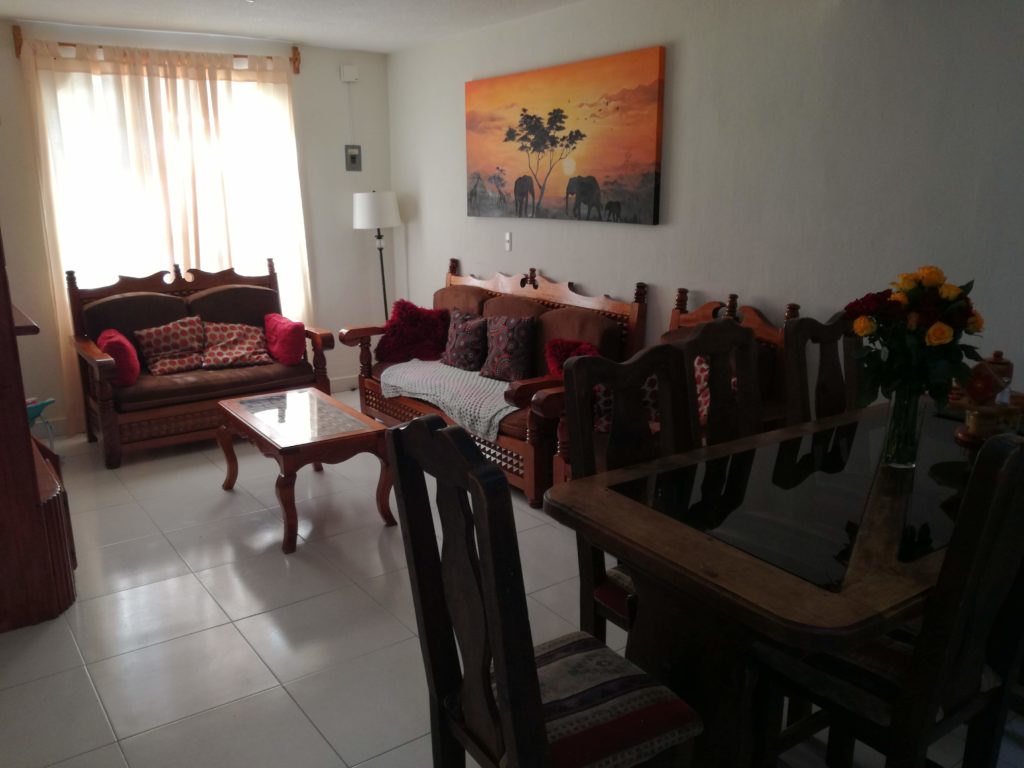
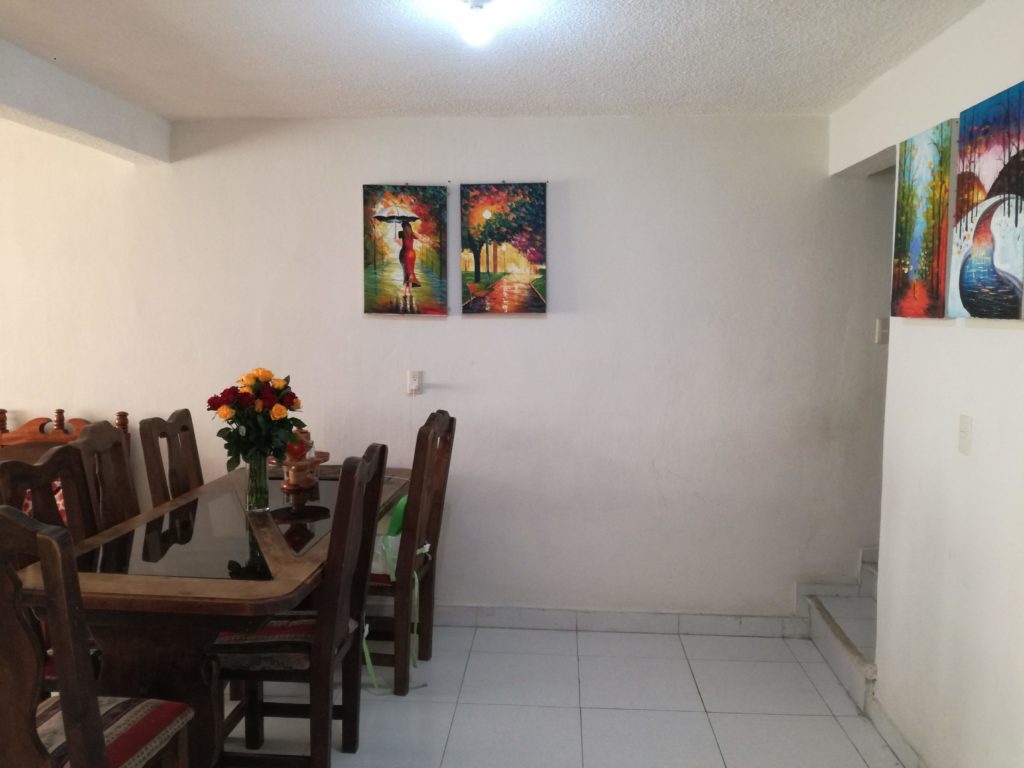
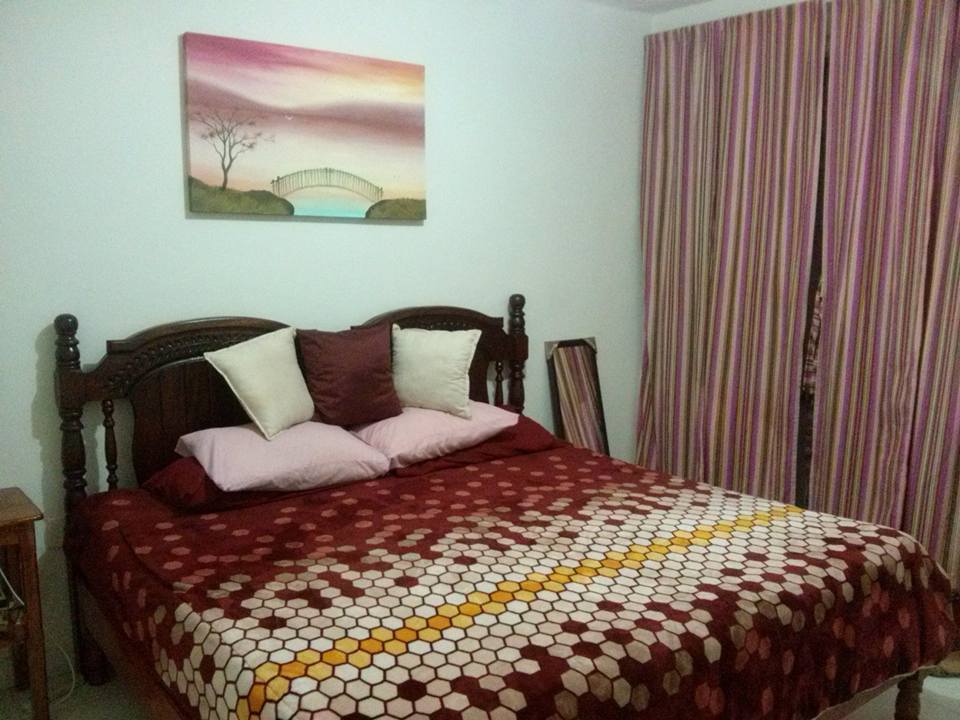
So even if we compare our current larger place to the smaller one we used to rent in Kentucky we still come out 75% cheaper here. Granted, what we pay is on the lower end (we got a sweet deal!) I’ve seen similar properties in the city rent for about $263 (5,000 pesos/month). But even with that upper extreme, rent is still 62% cheaper.
When we lived in Cabo San Lucas we rented this small (maybe 900 or 1000 sq foot) 2 bedroom, 1 bath house for 4,000 MXN per month. Taking into account that the exchange rate was less favorable back then (about 14/1) this came out to $285/month. Still not bad…not bad at all!
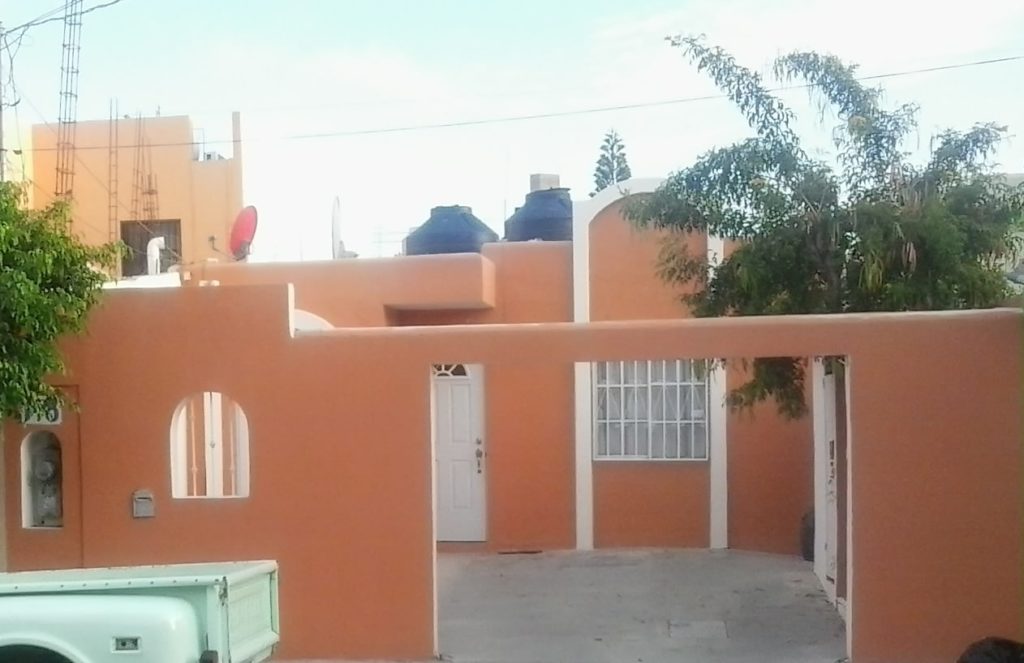
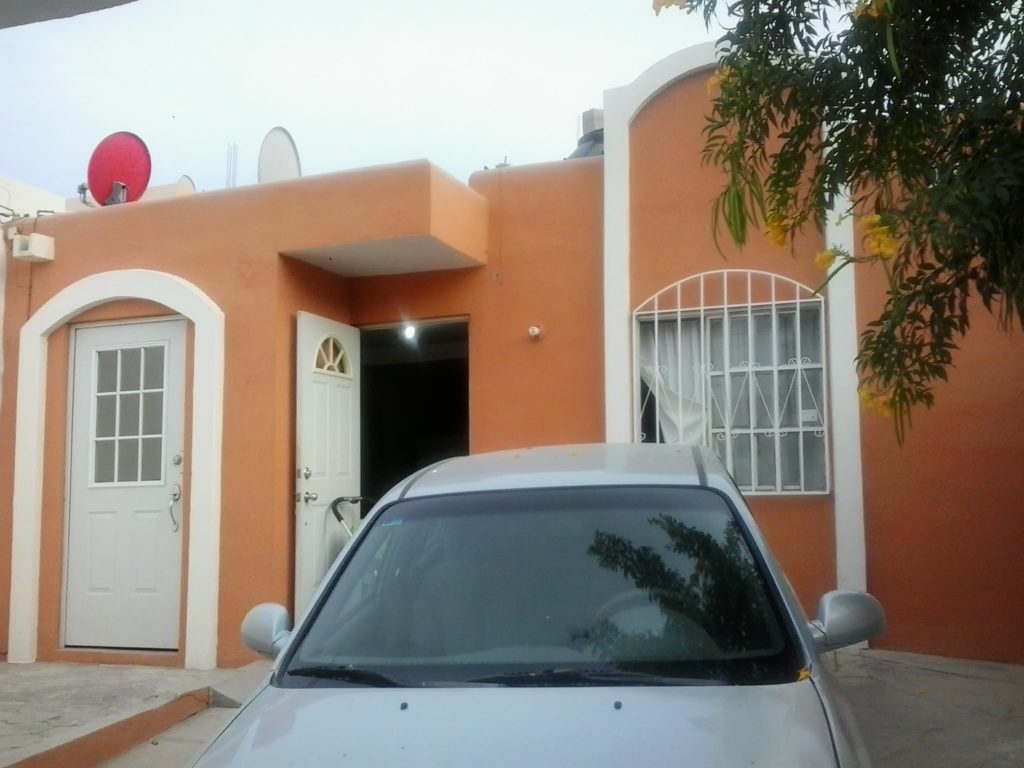
And what about buying a home?
The going price here in San Cristóbal to purchase a house similar to the one that we are currently renting is approximately $78,947 USD (1.5 million MXN). In the U.S. these will go for at least $150,000 on the low end. That’s a 47% difference!
Utilities, Internet, and Phone Costs in Mexico – 31%-80% cheaper than in the U.S.
Bills, bills, bills.
Isn’t adulting fun? Here’s a peek into what our monthly bills look like here in Mexico, stated in USD only for simplicity’s sake.
Electricity
Keep in mind that I am home most of the day during weekdays, lights are on, appliances are being used, etc…
Now we have a sweet setup here because San Cristóbal has mild weather, so A/C is never needed and heaters are only needed for a couple of months out of the year.
In the winter time when we might use some space heaters, that’s when the bill can go up to $30 USD.
In Cabo San Lucas, it was H-O-T!! We had A/C and there were months in which are electric bill was $50 USD, which was crazy expensive to us because we had grown accustomed to paying so little for everything.
Gas
We didn’t use gas in our apartment in the U.S. It was electric only. So I had to tack on to this utility section what we use for gas for cooking and water heating here in Mexico.
Here we use propane gas tanks, which are brought to the house, used until empty, and then the gas people come to replace it for you. We use about 1 tank per month.
So our grand total per month for combined Electric and Gas comes to $38 – $55. This is 31% – 65% cheaper than our $80-$110 electric-only bill in the U.S.
Water/sewage
Our water/sewage bill is about $8 USD, which is 80% cheaper than what we used to pay in the U.S.
And the price of water is the same every month (until they decide to raise it across the board). This is because we’re billed a set rate, not an amount based on usage.
A certain amount of water comes a couple times a week to fill our water tanks and from there, we’re free to use whatever we need and will always pay the same amount.
Water running out can be a problem in some areas, and we’ve experienced that in the past. Read all about that here!
But that has a lot to do with what neighborhood you’re in. It’s easy to find out the water schedule of a neighborhood before moving there. We haven’t had an issue with water running out for years.
Internet
We pay $28 USD per month for 20 mbps speed. So it’s not the fastest in the world, but it gets just about any job done, including having interactive ESL lessons with students in China. It’s about 57% less than the $65-ish dollars per month that we used to pay in The States.
Cell phone
Cell phone plans are a little funny here. They exist and they’re cheap, but the more popular options are the pay as you go prepaid deals.
Until recently, I had an unlimited call, text, and high data plan, which cost me about $18 USD per month. More recently I’ve switched to a monthly prepaid plan for $10.50 USD per month I still have everything I need and I never run out of anything.
So my husband and I combined never spend more than $28/month on our cell phones compared to the $80/month or more family plans that we used to have in the U.S. That’s a 65% difference!
FOOD costs in Mexico – 43% cheaper than in the U.S.

Food is one of those areas where you don’t even know how much you’re spending unless you get serious about budgeting. But it’s a crucial factor to consider in your cost of living in Mexico.
I’m strict about budgeting so I know exactly how much we spend on food. We’re a family of 4, in addition to our housekeeper who eats breakfast and comida (the main meal of the day) with us M-F.
Our kids are 6 years and 20-months-old. We cook at home every weekday for every meal.
Our extreme weekly grocery hauls (you know, the kind where it’s like embarrassing because there’s literally no more room left in the cart) cost us $380 USD per month (7,200 MXN) when we do the supermarket only. When we combine this with outdoor market shopping, we can sometimes get by with less.
Now it is EASY to spend just as much in food here as in the United States if you want to eat exactly the same things that you did there. For awhile, that’s pretty much what we did.
But I eventually learned to make substitutions with what was local and in season. For example, cheeses such as cheddar, ricotta, and mozzarella are pricier here since those are foreign imported items. So I often substitute with chihuahua, panela, and quesillo cheeses. Still works. Still delicious.
We like to eat out once or twice on the weekends. With each outing, we spend anywhere from $10 (if we’re just getting a pizza) to $26 in a family restaurant with 3 of us getting a meal and drink (my toddler still eats from our plates). If we go out for some tacos we’ll spend $5 for 10 tacos, which feeds all of us.
On average, we spend about $80/month eating out.
So our grand total comes to $460 for food.
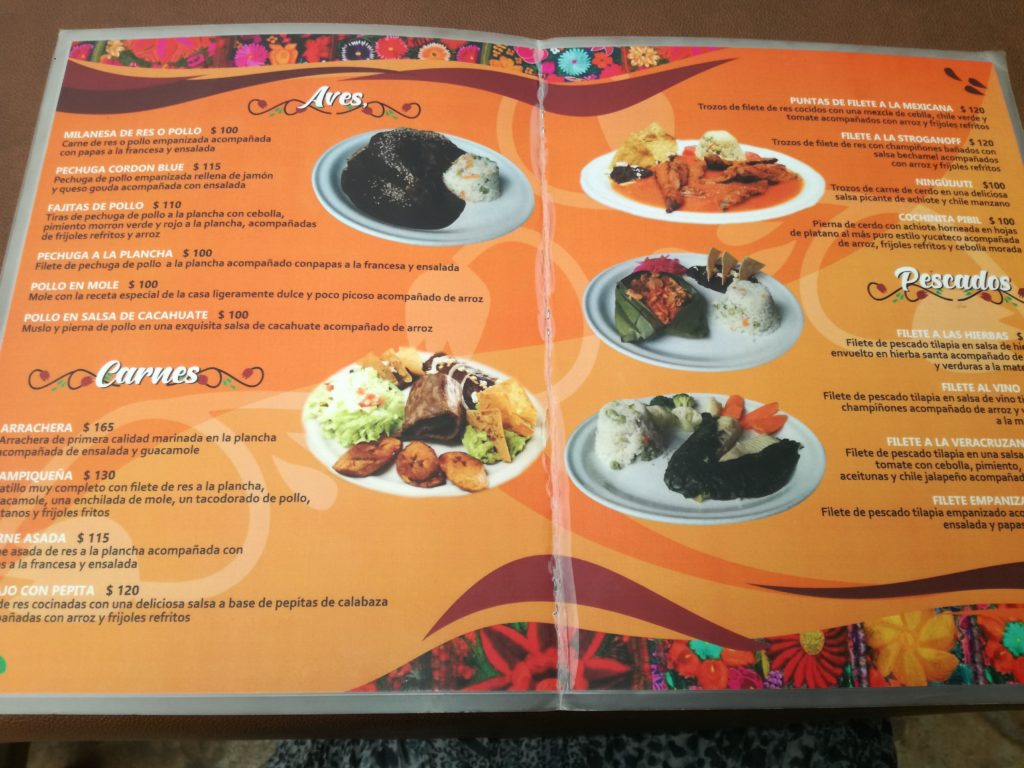

In the U.S. we used to spend $600/month on groceries (for just 2 or 3 people!!) and we probably spent $200 a month eating out. Yikes!
That’s $800 then, compared to $460 now, so a 43% difference.
Private Education in Mexico – 72% cheaper than in the U.S.
If you have children who will not be homeschooled, you really need to factor private education into your cost of living in Mexico. The standards of private schools tend to be much higher than in public schools as far as academics, parent/teacher communication, and even the teacher’s credentials.
Currently, we pay approximately $1,860 USD per year in tuition for my daughter’s private elementary school, which has been excellent and we all love.
She enjoys small class sizes of about 15 students, lots of individualized attention, excellent communication between parents and teachers, and lots (and lots of lots) of special events and activities.
Granted, I have no experience with private education in the U.S. and costs are all over the place by state. I found a national average $9,630, and a Kentucky average of $6,700. Again, I’ll mention that this city is on the low-mid range of cost of living and so was the city where we used to live in Kentucky. Therefore, I’ll go with the Kentucky figure in order to try to keep this apples to apples.
So $6,700 there compared to $1,860 here is a 72% difference.
Now even if we add in the books, the uniforms, the materials, and all the random stuff that they ask us for throughout the year, we pay about $2,420 USD here in Mexico, which is still a 64% difference compared to the tuition price ALONE in Kentucky.
Healthcare Costs in Mexico – 83% cheaper than in the U.S.
We all get sick and need to maintain our health. So a cost of living in Mexico comparison list wouldn’t be complete without talking about medical care.
Now this is probably the category with the most potential for variances, but to keep things simple, the 83% cheaper figure above is based on something standard – baby delivery without insurance.
In The States you will pay at least $10,000 USD to deliver your baby without insurance (and hopefully you would never find yourself in that situation!)
When I had my second daughter in 2017 here in Mexico, my total hospital/doctor bill was $1,737 USD. This was in one of the pricier private hospitals with a highly sought after doctor, so this is on the high end. But even so, the high end of Chiapas to the low end of anywhere in the U.S. was an 83% difference.
Sidenote: You do need to pay your bill in that moment before being released from the hospital. You won’t get bills in the mail. So definitely be prepared for that!
What about insurance? Obviously, insurance costs are going to vary enormously depending on various factors and what kind of coverage you have. So here’s just a two-sentence summary of our insurance situation, prior and current.
In the U.S., we used to pay somewhere around $3,600/year in insurance for 2, then later 3 people.
Here in Mexico, we paid about $650 USD for insurance for the year (and we’re now 4 people).
Now let’s compare out of pocket charges.
In the U.S. we paid a $30-$40 copay with each doctor’s visit.
Here in Mexico, to pay our doctors IN FULL for an office visit (because many don’t work with insurance) we pay $21-32, up to about $50 for a very high-end specialist. This pricing has stayed pretty consistent, in our experience, from Cabo San Lucas to down here in Chiapas,
What about hospitalizations and major procedures?
Here’s a real-life example from just 2 weeks ago at the time of publishing this post.
My husband had to go emergently to the hospital after having a high fever all week along with severe gastric problems.
We got to the hospital and he was evaluated within 2 minutes by a nurse, 5 minutes by the doctor, and we were in a room 5 minutes later.
He ended up being hospitalized for two nights – one night in the original hospital to which we had arrived and another night in a hospital in Tuxtla (about 1 hr away from us), the capital city of Chiapas. Actually, it’s the same hospital where I had my second daughter.
He was on IV meds the whole time, had an endoscopy on day 2, for which he had to be transported by ambulance from one hospital to another just because the doctor doesn’t do endoscopies in hospital #1.
He received excellent care the whole time and the nursing staff were honestly some of the friendliest I’ve ever run into.
We got physical copies of all lab results and all of the doctor’s medical summaries immediately at each facility to which we were taken. This is another plus about Mexico. There exists no long drawn out process to request your medical records.
Now we didn’t even reach our deductible because we have a $1,842 USD deductible (VERY high by Mexican standards) that I’ll probably be lowering next year after this experience. So we ended up paying everything out of pocket.
Our grand total of EVERYTHING, including the hospitalizations and doctors fees and labs, the ambulance, etc…etc… was $1,310 USD…out of pocket.
I’m not even going to try to imagine how much that would have cost in the U.S. We probably would have ended up paying the same amount just in copays on top of our $300/month insurance.
And in case you were wondering, my husband is fine. The final diagnoses was salmonellosis as well as gastric ulcers.
Housekeeping/Childcare Costs in Mexico – 92% cheaper than in the U.S.
This is where us busy mamas strike gold! As a work from home mommy, this is the one category where the cost of living in Mexico is so dramatically different, but the benefits so great that it’s changed my life completely!
According to USAToday, the national average gross weekly salary for a full-time live-out nannies is $705 (and just a few dollars lower for a live-in).
Let’s compare that to here in Chiapas, Mexico, where an excellent wage for a fulltime housekeeper/nanny/cook, whether they go home at night or live in the house, is $10.50 USD per day (200 MXN).
Minimum wage is half of that (5.40 USD per day) and many many domestic workers earn minimum wage (or less…yes less!). That is NOT a liveable wage, not even here.
So if you take the standard “good wage” for a domestic worker here in Chiapas of $10.50 per day ($52.50 for a 5-day week) then you’ll pay 92% less than what you would pay a full-time nanny in the U.S.
Conclusion
OK, let’s land this plane. In conclusion, here’s how much you can save by moving to Mexico.
HOUSING – 47% – 75% cheaper in Mexico
UTILITIES/INTERNET/PHONE – 31% – 80% cheaper in Mexico
FOOD – 43% cheaper in Mexico
PRIVATE EDUCATION – 72% cheaper in Mexico
MEDICAL – 83% cheaper in Mexico
HOUSEKEEPING – 92% cheaper in Mexico
There are so many ways to take advantage of the lower cost of living in Mexico.
Taking a fraction of a standard U.S. income, you can live well and enjoy your newfound freedom.
You can take the opportunity to really pad your savings and investment accounts.
Or you may choose to spend the same amount of money as you used to, but with a majorly upgraded lifestyle.
If you live in Mexico, I definitely want to know how your numbers compare to ours. Tell us in the comments below how much you spend on some of these items where you’re living.
Like this? Pin it! And follow me on Pinterest at https://www.pinterest.com/expatericaelsewhere
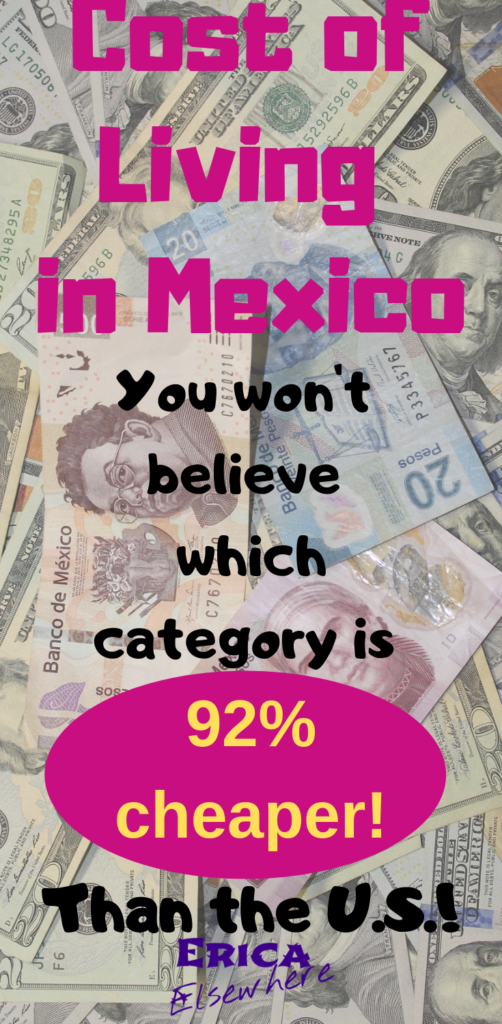
What to read next. 4 Reasons You Still Need to Budget as an Expat
Erica Ray
Latest posts by Erica Ray (see all)
- The Spanish Imperfect Tense (essential for good storytelling!) - February 10, 2025
- Real Spanish Conversation: El Trabajo (Spanish Listening Practice for Intermediate/Advanced) - January 14, 2025
- Por vs Para: The SIMPLEST way to understand and choose between them - January 14, 2025

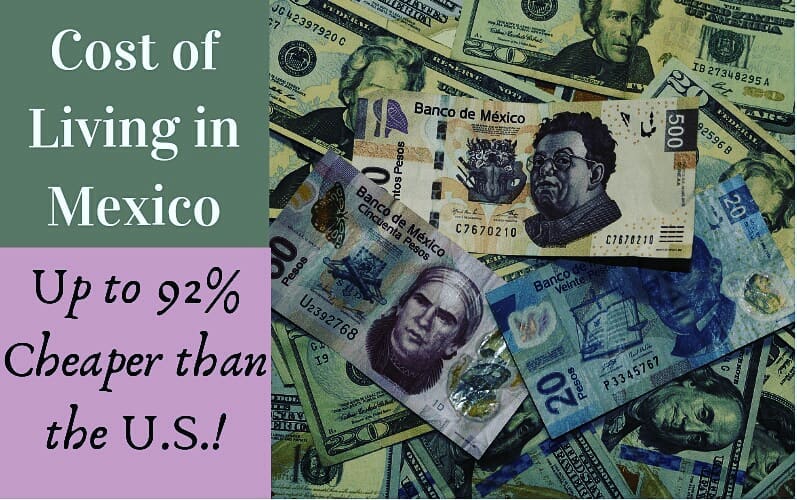
Hey there! I saw you I think on YouTube about a month ago,then coincidentally found this blog! Small online world!
Anyway, I’m still narrowing down where I’d like to love in Mexico, and how to get reoccurring income online. I’m considering getting a TEFL certification and maybe trying copywriting.
Do you know if one can support themselves with a TEFL cert down there? I’d probably work for one of the online companies at first, and then going freelance after I’ve gotten the hang of it.
Thanks for the great info, your content has been very helpful to me.
Hi there! Your plan of getting your TEFL certification and then working for an online company before going independent sounds great to me! Online English teaching was one of my income sources for a time and actually most of my English-speaking expat friends here also teach English online as their sole source of income. 🙂
Hi Erica, I am so inspired By your post. I am semi retired at 61 years young. Do you have a newsletter I can subscribe to? I am interésted in retiring in Mexico during the Arizona summer months. I would also like some insight on your work from home online. Best wishes hija. Elizabeth
Hi Elizabeth! I’m so glad that the post was helpful for you! Sure! With your permission, I will add your e-mail to my mailing list and you will get notified every time I publish a new post. As far as working from home you can check out this link for immediate income possibilities: https://ericaraylanguage.com/category/global-work-from-home-opportunities/ And I also discuss travel blogging for income here, although this one takes awhile to build up: https://ericaraylanguage.com/category/travel-blogging/ 🙂
We live in Costa Rica & Oaxaca de Juárez. I graduated from the University of the Americas in Cholula in 1977 & coincidentally, the university has a reunion this year in San Cristobal in October.
We’re have the websites RetireforLessinCostaRica& RetireinOaxacaMexico
We are retired so have a small pension of $1209 plus what we make. As far as I can see Oaxaca is more expensive than San Cristobal, but we’re not truly living there full-time yet, as we’re dividing our time between Costa Rica and Oaxaca. We just got temp residency today on a phone call from the Mexican embassy in San Jose Costa Rica. We are very excited.
My wife just started transcribing and proofing part time. We have lived in Costa Rica for 10 years and we are both from Baltimore, Maryland. We look forward to meeting you in October.
It’s nice that you’ve been able to experience a few different places. Congratulations on obtaining temporary residency in Mexico! It’s amazing how far a small pension can go in Mexico. You shouldn’t have any trouble finding affordability in Oaxaca as well. Oaxaca and Chiapas are two of the most inexpensive places to live in Mexico. So much has to do with finding out what the locals do and doing that thing instead of following exclusively the way of life of the expat communities. Although the latter can feel more comfortable in the beginning you will often be given the same quality of goods and services at a higher price.